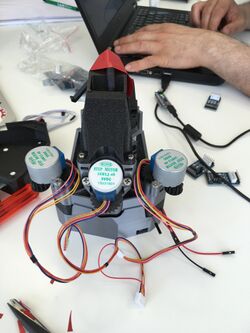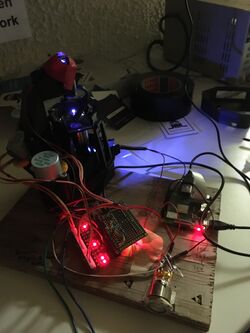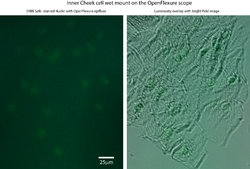Difference between revisions of "OpenFlexure Scope"
| (8 intermediate revisions by the same user not shown) | |||
| Line 1: | Line 1: | ||
Our first real build of an OpenFlexure Scope happened quite some time ago (23may19)! | Our first real build of an OpenFlexure Scope happened quite some time ago (23may19)! | ||
| − | However, we plan much more to come, especially for the 'Cheek Cell chip' project! | + | However, we plan much more to come, especially for the '''<nowiki/>'Cheek Cell chip' project!''' |
<br> | <br> | ||
| Line 17: | Line 17: | ||
There is a lot of old information in [https://forum.openhardware.science/t/openflexure-microscope-epifluorescence-acquisition/2099/22 this thread of the GOSH Forum].<br>In fact, we played with more power to the blue 'excitation' LED, but it was a filter problem that got resolved before the pandemic that got us able to see fluor nuclei. | There is a lot of old information in [https://forum.openhardware.science/t/openflexure-microscope-epifluorescence-acquisition/2099/22 this thread of the GOSH Forum].<br>In fact, we played with more power to the blue 'excitation' LED, but it was a filter problem that got resolved before the pandemic that got us able to see fluor nuclei. | ||
| − | This is the filter set needed. | + | This is the filter set needed to make this work on sybr-safe stained cells. |
| − | 1 550nm dichroic mirror, 25x16mm (GFP) Mfr: Comar; Part No. 550 1Y 116 | + | *1 550nm dichroic mirror, 25x16mm (GFP) Mfr: Comar; Part No. 550 1Y 116 |
| + | *1 490nm excitation filter, 25x16mm (GFP) Mfr: Comar; Part No. 495 1K 116 | ||
| + | *1 500nm emission filter, a ‘long-pass’ Comar 510 IY 116 | ||
| − | |||
| − | |||
| − | |||
[[File:Epifluor with OpenFlexure.png|250px|thumb]] | [[File:Epifluor with OpenFlexure.png|250px|thumb]] | ||
| Line 34: | Line 33: | ||
<br> | <br> | ||
| − | The latest plan, as we are hope we are finally seeing the light at the end of the tunnel out of this pandemic time (March 2022), will be to try the [https://www.raspberrypi.com/products/raspberry-pi-high-quality-camera/ more sensitive Raspberry Pi camera] and the more stable filter insertion epi- | + | The latest plan, as we are hope we are finally seeing the light at the end of the tunnel out of this pandemic time (March 2022), will be to try the a higher magnification lens that is more sensitive to fluorescence (20x FLUO-TAR), in place of the 10x PL objective used in our first tests. We also want to use [https://www.raspberrypi.com/products/raspberry-pi-high-quality-camera/ more sensitive Raspberry Pi camera] and the more stable filter insertion epi-fluor version of OpenFlexure, to see if we can also visualise the comet tails... Maybe we can get support to do it together?? **([https://forum.openhardware.science/t/apply-here-for-gosh-s-2022-regional-events-funding-round-2/3511/6  GOSH Community ForumGOSH Community Forum asking for GOSH funding, March 2022], and maybe we will even get that support!) |
| − | Then, the 'cheek cell chip' | + | Then, the 'cheek cell chip' fluidic prototypes would get incorporated in place of the current slide holder, and all our hopes will finally get tested for DNA damage quantitation by both the micronuclei and comets from the same cell samples, and the fun can really begin (chocolate? blueberries?) with the Cheek Cell Chip! |
You can help! | You can help! | ||
| + | |||
| + | Here is the [[AGiR! for genomic integrity|original Genomic integrity project page]] at Hackuarium, for more info. | ||
| + | |||
| + | [[Category:Work In Progress]] | ||
Revision as of 18:06, 24 April 2022
Our first real build of an OpenFlexure Scope happened quite some time ago (23may19)!
However, we plan much more to come, especially for the 'Cheek Cell chip' project!
We basically followed instructions from GitHub.
Actuator Assembly
Used WD40 to oil the screws before twisting down.
Used Blue LED below, with 150ohm resister to start (maybe not best?)
Used longer screws (15mm) to attach the motors.
The program openflexure ev is put into the fedora system of the 'inner sanctum' space.
login with pi@openflexture.local (and pass from our dear old mascot! )
The motor board was set up by Masoud and running already by December 2019,
but we were not yet able to take overall panoramas of samples.
Figured out exactly how to wire things up, so could do bright field or epifluor, and we played with different powers to the blue LED to get more excitation light..
There is a lot of old information in this thread of the GOSH Forum.
In fact, we played with more power to the blue 'excitation' LED, but it was a filter problem that got resolved before the pandemic that got us able to see fluor nuclei.
This is the filter set needed to make this work on sybr-safe stained cells.
- 1 550nm dichroic mirror, 25x16mm (GFP) Mfr: Comar; Part No. 550 1Y 116
- 1 490nm excitation filter, 25x16mm (GFP) Mfr: Comar; Part No. 495 1K 116
- 1 500nm emission filter, a ‘long-pass’ Comar 510 IY 116
However, as of dec2019, we were only able to image nuclei stained with sybr safe, not yet actual comet tails...
Much more would come soon, we thought, before we we struck by the SARS-CoV-2 pandemic, including the full configuration so far...
(thanks to the [www.openflexure.org OpenFlexure] crew at Bath, UK (and elsewhere!), and to all Octanis members, and Masoud for getting the motors to work!!)
The latest plan, as we are hope we are finally seeing the light at the end of the tunnel out of this pandemic time (March 2022), will be to try the a higher magnification lens that is more sensitive to fluorescence (20x FLUO-TAR), in place of the 10x PL objective used in our first tests. We also want to use more sensitive Raspberry Pi camera and the more stable filter insertion epi-fluor version of OpenFlexure, to see if we can also visualise the comet tails... Maybe we can get support to do it together?? **(asking for GOSH funding, March 2022, and maybe we will even get that support!)
Then, the 'cheek cell chip' fluidic prototypes would get incorporated in place of the current slide holder, and all our hopes will finally get tested for DNA damage quantitation by both the micronuclei and comets from the same cell samples, and the fun can really begin (chocolate? blueberries?) with the Cheek Cell Chip!
You can help!
Here is the original Genomic integrity project page at Hackuarium, for more info.


